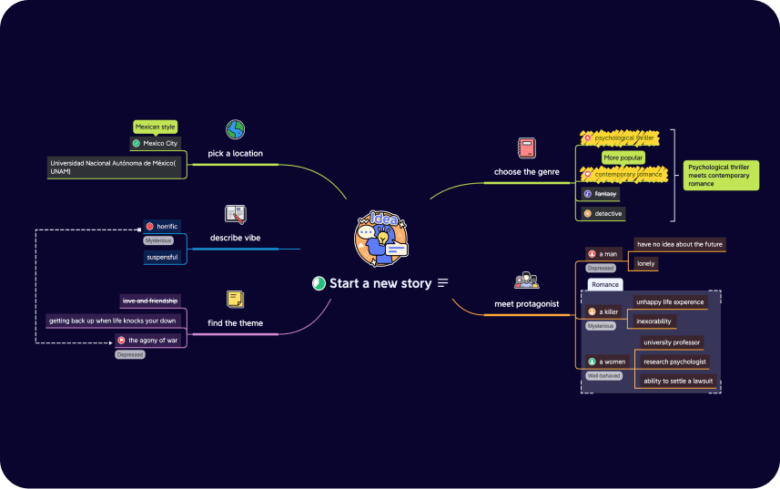Two philosophers walk into a bar. One turns to the other and says, “Do you believe in sense-making?” The other responds, “I’m not sure, but it seems to be the only way to make sense out of all this digital nonsense!”
Sensemaking is the new cognitive skill becoming increasingly popular in our digital age, with one certainty — master it or get buried under the truckloads of overwhelming information.
But how does it help you filter through clout and find relevant information? What strategies are there for preventing mind overload, and keeping you organized and fresh?

Source: alloy.institute
Contents
Making sense of the information overload
Sensemaking — the elusive art of making sense of the nonsensical. It’s the ability modern-day digital ninjas have become masters of. It’s how they escape the constant bombardment of nonessential information and arrive at the other side, the side of information bliss with a perfect understanding of what’s significant.
Of course, in a time when there are endless amounts of information, it’s not really easy to keep yourself from information overload! So, how do you do it?
In that context, sensemaking is a process of taking multiple pieces of information you’ve experienced and synthesizing them into one coherent whole. At its core, it’s about recognizing patterns, making connections, and drawing conclusions.
It’s the only way to move from chaos to information clarity.
Sensemaking – The unspoken truth of information overload
Here’s what they don’t tell you: Filtering through the clout is just a tiny part of it. What sensemaking is truly about is decisions!
Humans like to analyze almost everything. From that, paralysis by analysis is born. It’s precisely that feeling of being paralyzed by overwhelming information that sensemaking is saving us from.
Where to start, how to make sense of it, and what to focus on are mind-boggling questions the digital workforce is trying to figure out. Luckily, there are secret strategies sensemaking teaches on how to answer them.

Source: epicpeople.org
5 strategies for coping with information overload
Filtering through a digital mess is a challenge of its own. It’s easy to say you need to develop:
- Information categorization
- Comparison
- Pattern recognition
- Information visualization
They all sound like the sticky notes you’d put on the Kanban board. But that’s not the right way to do it!
These are five tried-and-tested strategies of sensemaking good software development outsourcing companies use as part of their daily operations.
1. Set information prioritize
Here’s a free pro tip: Set yourself in the role of the processor in your laptop. No, don’t turn yourself into a cyborg, but learn how they deal with information overload.
Processors can’t handle every piece of information out there, or they overcook and explode!
To prevent that catastrophe they prioritize which bits of information to focus on. They figure out what pieces of information are for the long-term and what are for short-term processes.
Once they figure it out, they focus all their resources and computing power on urgent tasks requiring immediate action. That’s how they achieve the golden 80/20 rule.
20% of hard-core, laser-focused efforts = 80% of productive high-quality results.
What’s left is a smooth dance of delegating or eliminating with a frequent reevaluation of priorities.
2. Filtering effectively through clout
You figured out how to prioritize the information coming your way, but how do you filter it? What’s the secret key, and how do the productivity ninjas do it?
Here are a couple of key steps that’ll turn you into a filtering digital zen master:
- Find your criteria for evaluating information. This includes relevance, timeliness, and credibility. It’s a beginner’s step to 10x-ing your decision-making speed.
- Search filters in software are there for a reason. Take them by the horns and unlock advanced search options!
- RSS (Really Simple Syndication) feed is a miracle worker. Scanning headlines and staying up-to-date has never been easier. It’s also a light-speed method of finding relevant information, without being distracted by the clout.
- Find your gold mine, your trusted source! By focusing your resources and efforts on trustworthy websites, influencers, and blogs developed over time, you stop jumping hoops and wasting precious time finding the right information.
3. Synthesizing the information
The information passed through prioritizing and filtering. What do you do next?
The sensemaking bible tells us to look for patterns, form connections, and draw information-based conclusions. Seems like a straightforward process, but that’s where you’ll fall into the sensemaking trap!
To properly synthesize filtered information you need to:
- Identify key themes — Look at what pieces of information have a common theme or topic. Find patterns and connections between those multiple sources that’ll help you in your theme-identification.
- Organize them like pro-organizer their pantry — Be prepared to craft a mind map or a topic outline. It’ll keep everything nice, organized, and tidy, just like your grandma’s pantry.
- Compare and contrast information — Find similarities or differences in your organized information library. It helps you with building a more nuanced understanding of the topic or information cluster.
- Communicate your findings — Creating a summary or a report helps you communicate your findings clearly and concisely. What’s on the paper and said is better than what’s on the mind and forgotten!

Source: macrumors.com
4. Don’t forget about tools and resources at your disposal
Sensemaking and keeping track of your information cluster with pen and paper is so stone age! Time to level up!
Modern-day digital tools take away the complex part of sensemaking, turning it into a more productive, effective, and foolproof process. Consider tools like:
- Information management tools (Evernote, Obsidian, Google Keep, Trello, ClickUp)
- Information databases (JSTOR, PubMed, LibGen, Web of Science)
- Visualization tools (Tableau, Infogram, Google Data Studio)
- Content aggregators (Feedly, Flipboard, and the one we can’t live without – Reddit)
- Mind mapping tools (MindMeister, XMind, Obsidian)
5. Remember – you’re a human
Go dark! Disconnect! You’re not an AI that can process, organize, and synthesize information 24/7.
At Code Power, we like to encourage our teammates to unplug, go exercise, practice mindfulness, and empty their information reservoirs. It’s how we re-energize our teams and keep digital overload at a minimum.
Sensemaking requires a “disconnect” period from the grueling pressure of information overload. It’s how you fully master the skill and become more resilient to mental exhaustion.

Conquer your cognitive overload – Embrace sensemaking
Let’s keep it real: Surviving in the modern day’s digital age is a **insert curse word**!
It’s tough cutting through the noise and making informed decisions you won’t regret. And don’t even get me started on putting different bits together to understand what’s important or not!
That’s why sensemaking is born — as sharp as a Damascus steel, coping knife capable of cutting through the thickest clout and information overload. Using those five strategies, you’ll forge yourself into a digital warrior worthy of wielding it.
